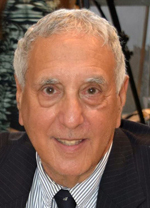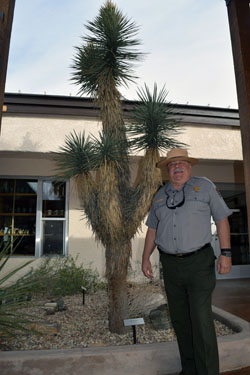
By Donald H. Harrison


JOSHUA TREE NATIONAL PARK, California – The story is told on this national park’s website that Mormon travelers gave the Joshua Tree its name: “Legend has it that these pioneers named the tree after the biblical figure, Joshua, seeing the limbs of the tree as outstretched in supplication, guiding the travelers westward.”[1] The strange-looking Joshua Tree is known to botanists as Yucca brevifolia .
My impression is that something got lost in the retelling of the legend. I wouldn’t be surprised if the imaginative Mormon travelers in actuality had recalled the story of Joshua pointing his spear toward the city of Ai, and holding it in that position, until the Israelites defeated their enemies in battle.
The Tanach, or Hebrew Bible, replaces God’s four-letter Hebrew name with the word “Hashem” which means “the name.” Here’s how the Stone edition of the Tanach translates the story of Joshua and his spear in the Book of Joshua.
Joshua 8:18: Hashem said to Joshua, “Stretch forth with the spear that is in your hand toward Ai, for in your hand will I give it” and Joshua stretched forth with the spear that was in his hand toward the city. 19. The ambush party rose quickly from its place and ran when he stretched forth his hand; they entered the city and conquered it; then they hastened and set the city afire. … 26. Joshua did not withdraw his hand that he had stretched out with his spear until he had destroyed all the inhabitants of Ai.
In between verses 19 and 26 of this section is a description of how Joshua’s forces slew 12,000 people—the entire population of Ai–even as they previously had wiped out all the inhabitants of Jericho. In later sections of the Book of Joshua, Joshua’s army similarly killed all the residents of almost every Canaanite city in its path.
Reading about these genocides should make any modern reader cringe. Perhaps someone who believes every word of the Bible was either written by God, or divinely inspired, can be sanguine about the massacres described in the Book of Joshua. In such a believer’s view, if the people of Ai were mass murdered at God’s command, they must have done something to deserve it—even as other large populations, such as those who lived during Noah’s era, and, later in the Bible, those who were the inhabitants of the cities of Sodom and Gomorrah, deserved their mass extinctions.
The name “Joshua Tree” has become part of the English language, but, if indeed, the story of the biblical Joshua has been sanitized, as I suspect it has, by the National Park Service, it’s hard to blame the stewards of America’s treasured lands for wanting to direct visitors’ attention to other subjects.
In touring a beautiful desert wilderness, where the eye is delighted by the juxtaposition of magical looking plant life and imposing rock formations, why would anyone want to be reminded of such tales of carnage?
*
I had the opportunity to talk about other matters with Ranger George Land, who is the community outreach ranger and volunteer coordinator at Joshua Tree National Park. A former newspaperman and computer storage systems marketer, he joined the park service in 2011 as a public relations specialist in time to help celebrate the 75th anniversary of the Joshua Tree area being designated in 1936 as a National Monument by President Franklin D. Roosevelt. During President Bill Clinton’s administration in 1994, Joshua Tree National Monument was upgraded to a National Park.
What’s the difference? According to Land, a National Monument can be designated by a President’s executive order, whereas a National Park is created by a full act of Congress. From a legal standpoint, a National Park has more permanency.
Joshua Tree National Park is 792,623 acres, making its size larger than that of the State of Rhode Island, which measures 775,900 acres. Joshua Tree National Park includes two different kinds of ecosystems, Land related. The lower desert is part of the Colorado Desert, which is an extension of the Sonoran Desert that runs through Arizona and parts of Mexico. The ecosystem that is higher in elevation is the Mojave Desert, “where most of the Joshua Trees and the iconic rock formations are,” Land told me. A staff of 110 people manages the overall desert park.
Two factors had teamed up against the desert prior to its protection as a National Monument in 1936, according to Land. One problem was the mass production of affordable automobiles by Henry Ford, making transportation to the desert possible and frequent for ordinary citizens. The second factor was the Spanish architecture very much in vogue in California at the time.
“So, it was kind of a perfect storm,” Land said. “People would come with their shovels and buckets and dig up half the plant life around here, then take them back to their gardens.” The desert plants often died after transplantation, California’s coastal climate not conducive to their health. The desert, meanwhile, was suffering degradation.
A Pasadena socialite, Minerva Hamilton Hoyt, as wise as the Roman goddess for whom she was named, became alarmed by the situation. She successfully petitioned President Franklin Delano Roosevelt to extend government protection to the area by his executive order.
A plaque placed in 1980 by the E. Clampus Vitus Society dubs Hoyt the “apostle of the cacti” and goes on to say that “her tireless efforts to establish Joshua Tree National Monument contributed to a heightened appreciation, not only of the Joshua Tree, but of the total desert environment.”
Land said that the Joshua “Tree” actually is a misnomer. It’s not a tree. It is a yucca plant. If you cut through it, you wouldn’t find rings for each year of growth. Instead you would find a “big, white pulpy mass,” Land said.
The plant grows slowly, approximately an inch and a half a year, so if a Joshua Tree towers over you, as many of them do, you can do the math and find out that they are very old.
During World War II, one company experimented with using the Joshua Tree to make splints for the wounded, but this idea proved economically infeasible, according to Land. During earlier times when such Native American groups as the Serrano, the Chemehuevi, and the Cahuilla frequented this desert, the seeds of the Joshua Tree were crushed, mixed with water, and fried on a hot rock “to make a pancake kind of thing,” Land said. The Native Americans also used the fibers of the plant for weaving bags and sandals, he added.
The large plants are fairly fire resistant, continuing to stand even after grass fires have burned through the area. Sometimes, however, the Joshua Trees are scorched badly enough that the outer bark can no longer prevent the plant from being infested by insects.
Small birds and land animals find a natural refuge in the Joshua Tree, because they are able to hide between or under its sharp leaves, according to Land.
Many of the visitors to Joshua Tree National Park take “windshield tours” of the park, entering by car at one of the park’s three main entrances and leaving the park from another. Nancy and I stayed the night before our tour at a very pleasant Rodeway Inn in Twenty Nine Palms. In the morning we drove to the nearby entrance at the northern part of the park, and after meeting with Ranger Land, we drove leisurely to the southern exit at Joshua Tree Village, seeing along the way many memorable views. There were ample places along the road to pull over, take photos, or to get out of the car, and go hiking.
*
Harrison is editor of San Diego Jewish World. He may be contacted via donald.harrison@sdjewishworld.com
[1] https://www.nps.gov/jotr/learn/nature/jtrees.htm (Accessed November 16, 2017)